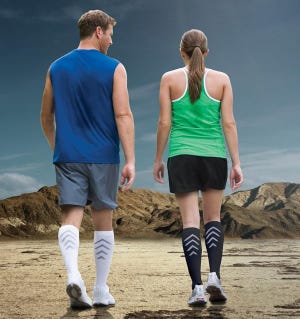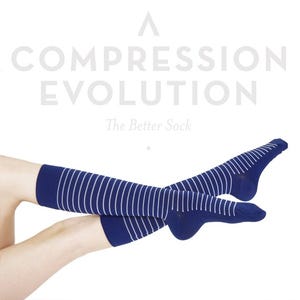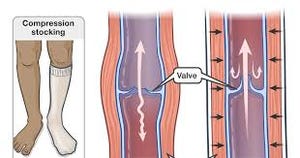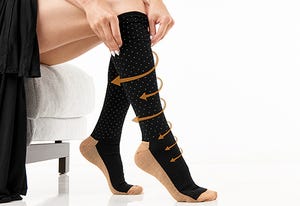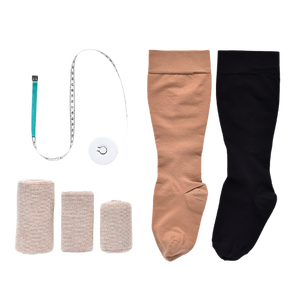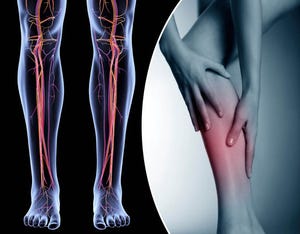Getting from here to there quickly is what air travel is all about. Whether you’re traveling in luxury in first class, or stuck on a long flight, cramped in coach, flying can be uncomfortable for many passengers due to the toll it can take on your circulation. While the risk of suffering a blood clot due to circulatory changes is low for the average person with no medical issues, like many people, when you finally land at your destination you may find that your ankles, calves, or thighs have swollen to twice their normal size and walking to the baggage claim may cause discomfort and pain.
While there may be stereotypes about compression socks being typically suited for the elderly or marathon runners, when it comes to air travel, they are essential for anyone with an underlying health risk. They’re also beneficial for anyone wanting to reduce leg stress during and after a flight. For example, pregnant women often suffer from swollen legs and ankles due to carrying extra weight while walking, but even sitting for extended periods of time on a plane can exacerbate the discomfort.
If you are a frequent flyer or a long-haul flight is in your future, compression socks are a must-have in your carry-on baggage. Like eye masks and neck pillows, compression socks can greatly increase your personal comfort while traveling by air – and they can actually prevent further health issues down the road. Depending on the style, compression stockings are designed to provide compression pressure to the legs, ankles, and knees of people of all ages and health status by helping to increase circulation in the legs, reducing the risk of swelling or suffering serious complications such as deep vein thrombosis (DVT) or blood clots during a flight.
Who Can Benefit From Travel Socks?
While your doctor may prescribe compression socks due to various serious health conditions that can be exacerbated during air travel, they can also relieve general leg fatigue and the general swelling many healthy air travelers experience. Some of the more common reasons people wear compression socks on their flight are due to concerns about:
- Spider veins
- Varicose veins
- Edema
- Diabetes
How do Compression Socks Work for Travel?
When traveling, compression socks deliver steady, firm pressure to your ankles, calves, knees, and thighs which helps your leg muscles and veins circulate blood more effectively. By gently squeezing your legs they help keep your blood from pooling or stagnating, according to the Mayo Clinic. They are safe, easy to use, and are an inexpensive way to keep blood circulating properly.
How Much Compression for Travel Socks is Best?
Compression levels determine how tight the socks will be and the pressure put on your legs. People who have existing circulation issues generally need a higher compression level, while those in good health may use them to fight the effects of long-haul flights. The compression levels range from mild to extra firm. If the travel socks cause pain or feel too tight, you probably have the wrong compression level or size. Using the wrong compression level can cause more harm than good, so remember that they should feel like they are giving your legs a gentle, supportive hug, not like they’re strangling your legs.
Travel Socks vs Compression Socks
Whether they are referred to as travel socks, compression socks, or flight socks, they are all one and the same. Sometimes they’re even called compression stockings. You can wear your travel socks at home, and your compression socks on a flight. Generally, the only differences are their compression level, and whether they are uniform or graduated. Uniform compression socks provide uniform pressure throughout the entire sock, while travel socks that are graduated provide more pressure on the ankle. Additionally, there are different styles of compression socks:
Ankle Socks – Span from toe to ankle.
Knee Socks – Run from toe to knee for extra support.
Thigh Hi – Provide support from toe to thigh.
Sleeve – A footless sock that begins at the ankle instead of the toe.
What Does the Compression Socks mmHg for Travel Mean?
When shopping for travel socks, you’ll notice they are marked according to their mmHg. Much like how blood pressure is calculated, mmHg indicates the level of compression or pressure and stands for “millimeters of mercury”. There are five general mmHg levels of compression:
- 8-15 mmHg: This level provides the least amount of pressure. By gently improving circulation they help control minor swelling, energizing your legs and providing relief for achy, tired legs.
- 15-20 mmHg: This mild compression level prevents deep vein thrombosis during air travel, and offers minor to moderate relief for the aching and swelling commonly experienced while sitting for long periods of time, especially while pregnant.
- 20-30 mmHg: Also commonly called “Class I" or “firm compression”, this is most frequently prescribed compression level, offering moderate pressure which can help alleviate mild to moderate discomfort for a variety of conditions, including post-sclerotherapy, deep vein thrombosis, edema, and varicose veins.
- 30-40 mmHg: Often prescribed to heal venous statis ulcers and post-scleropathy, this level also offers relief for people suffering from deep vein thrombosis, varicose veins, and severe edema. Sometimes referred to as Class II compression, this compression sock level requires doctor supervision.
- 40-50 mmHg: This compression level is commonly referred to as “Class iii”. It is the highest level of compression socks, typically used to treat post-thrombotic syndrome and chronic venous insufficiency, and should only be worn as prescribed by your medical professional.
Travel Socks aren’t Just for In-Flight Use
While compression socks can provide much-appreciated relief to travel-weary legs while flying, they also are great for post-flight activities such as hiking or skiing after you’ve reached your destination. Toss a pair in your carry-on baggage, or give as a thoughtful gift to friends and family who are frequent travelers.

